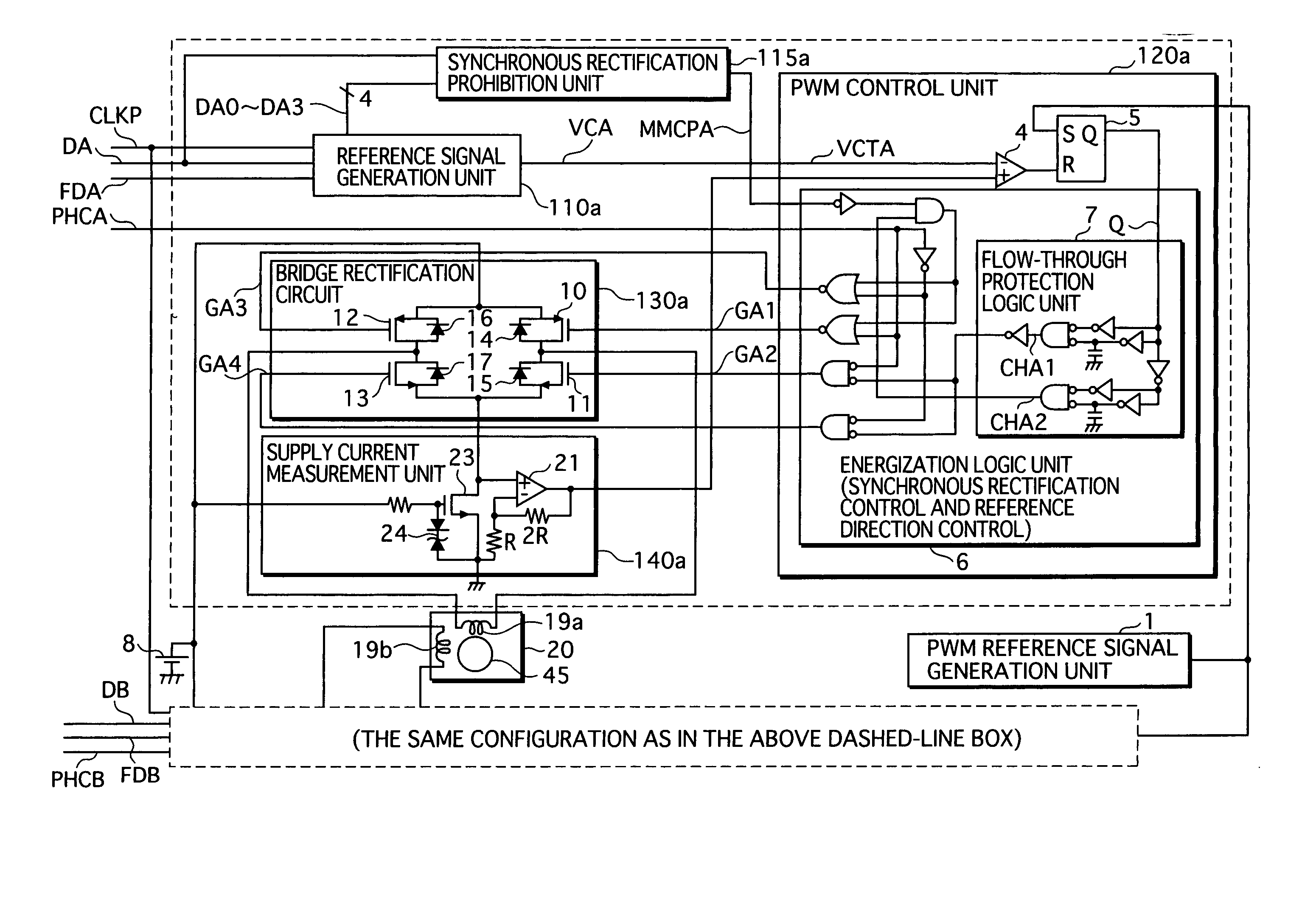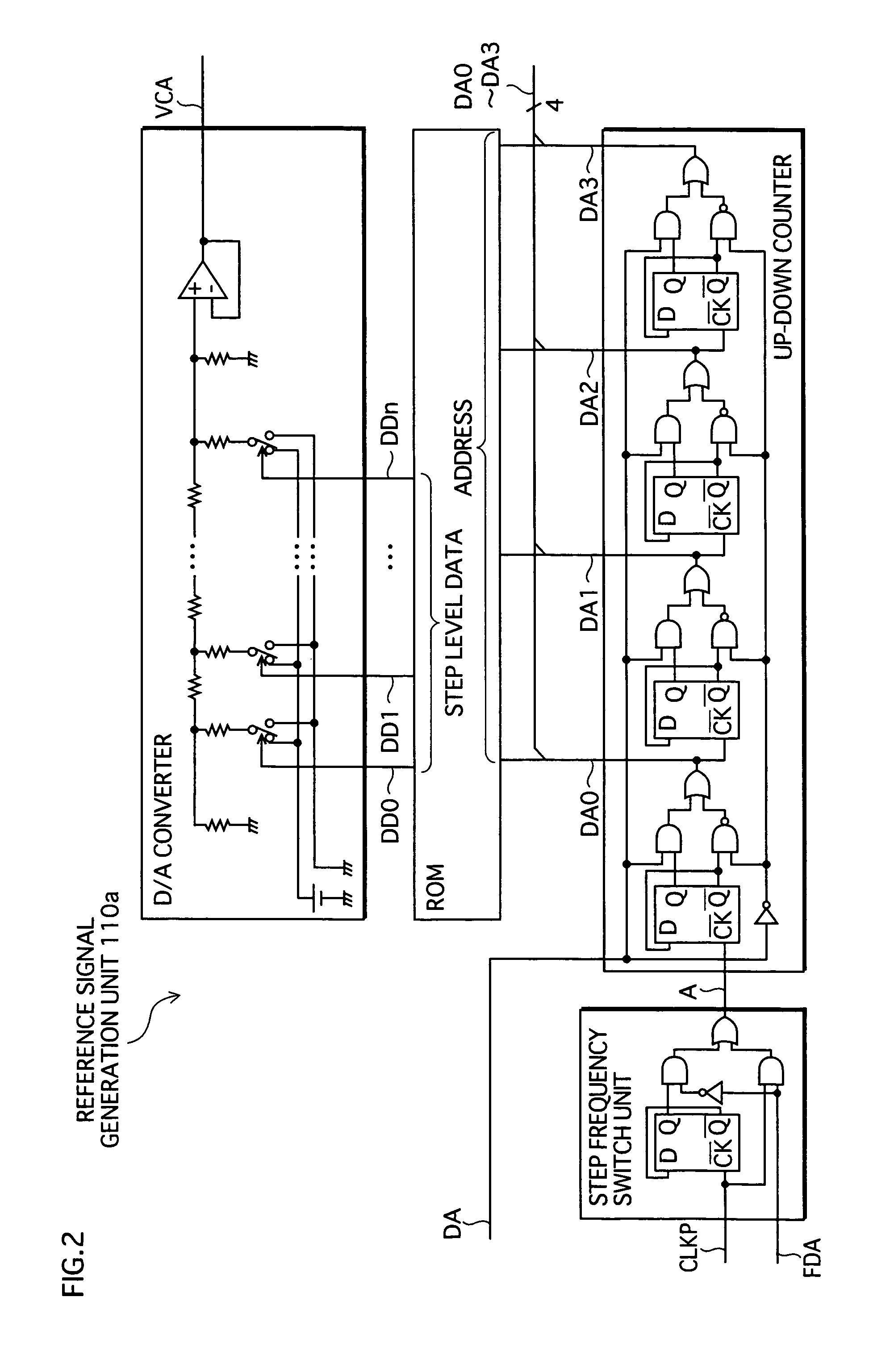Stepping motor drive device and method
a technology of stepping motor and drive device, which is applied in the direction of electric controllers, dynamo-electric converter control, instruments, etc., can solve the problems of slow attenuation of coil current at the time of the staircase signal decreasing, poor follow-up of coil current of the staircase signal, and degradation of the recorded image, etc., to achieve rapid rate, reduce vibration and noise, and enhance power supply efficiency
- Summary
- Abstract
- Description
- Claims
- Application Information
AI Technical Summary
Benefits of technology
Problems solved by technology
Method used
Image
Examples
first embodiment
1. First Embodiment
[0075] A stepping motor drive device of the first embodiment of the present invention generates a reference signal that represents a limit indicator, and exercises PWM (Pulse Width Modulation) control on a current supplied to the motor coil, according to the limit indicator. More specifically, the PWM control is executed using a current chopper method.
[0076] In addition, the stepping motor drive device implements synchronous rectification. In this rectification process, a switch for the synchronous rectification is brought into conduction and forms a closed circuit together with the motor coil during the period when the current supply to the motor coil is stopped. In this closed circuit, a regenerative current from the motor coil is circulated through the switch. However, the switch drops out of conduction at least for a period of time when the limit indicator represented by the reference signal is decreasing, and the regenerative current from the motor coil is c...
second embodiment
2. Second Embodiment
[0127] A stepping motor drive device of the second embodiment of the present invention differs from the first embodiment in the configuration relevant to the SR prohibition signal MMCPA generation. The following mainly describes the differences of the second embodiment from the first embodiment.
2.1 Overall Configuration
[0128]FIG. 11 is a functional block diagram showing an overall configuration of the stepping motor drive device of the second embodiment. Compared to the first embodiment, a SR prohibition unit 117a is used, instead of the SR prohibition unit 115a.
[0129] The SR prohibition unit 117a is configured so as to vary the time portion of which the SR prohibition signal MMCPA is being outputted according to program signals PRGA0 and PRGA1 provided from outside.
2.2 SR Prohibition Unit 117a
[0130]FIG. 12 is a functional block diagram showing a detailed configuration of the SR prohibition unit 117a. When the count value DA0-DA3 is between 0 and 7, the SR p...
third embodiment
3. Third Embodiment
[0133] A stepping motor drive device of the third embodiment of the present invention differs from the first embodiment in that a unit for delaying the polarity signal is added. The following mainly describes the differences of the third embodiment from the first embodiment.
3.1 Overall Configuration
[0134]FIG. 13 is a functional block diagram showing an overall configuration of a stepping motor drive device according to the third embodiment. Note that a stepping motor which is driven by the device, is also shown in the figure. This stepping motor drive device is configured by adding a timing adjustment unit 116a to the first embodiment (see FIG. 1). The timing adjustment unit 116a outputs the polarity signal PHCA, to the energization logic unit 6, with a delay of a specified period of time.
3.2 Timing Adjustment Unit 116a
[0135]FIG. 14 is a functional block diagram showing a detailed configuration of the timing adjustment unit 116a. Being input the polarity signa...
PUM
 Login to view more
Login to view more Abstract
Description
Claims
Application Information
 Login to view more
Login to view more - R&D Engineer
- R&D Manager
- IP Professional
- Industry Leading Data Capabilities
- Powerful AI technology
- Patent DNA Extraction
Browse by: Latest US Patents, China's latest patents, Technical Efficacy Thesaurus, Application Domain, Technology Topic.
© 2024 PatSnap. All rights reserved.Legal|Privacy policy|Modern Slavery Act Transparency Statement|Sitemap



